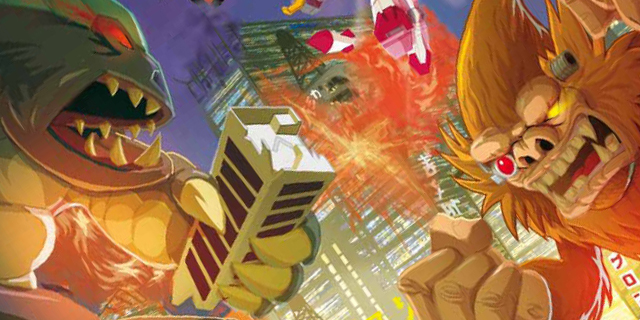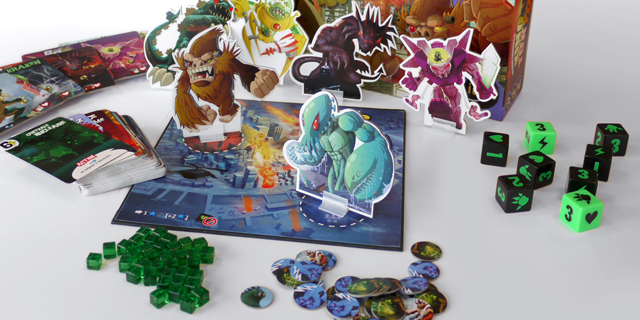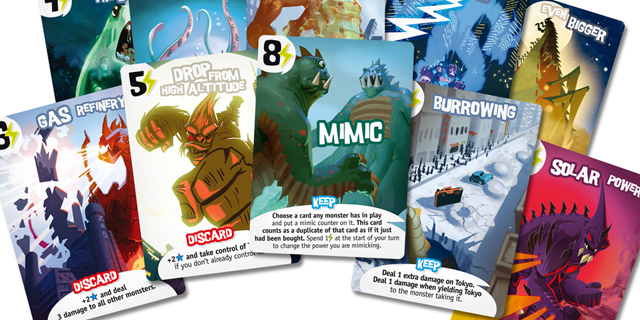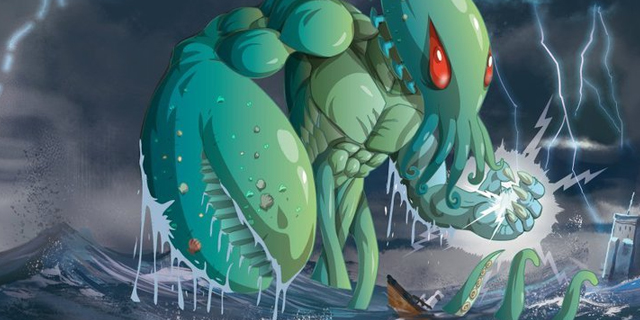
One of the more widely-disliked game mechanics available to designers is player elimination. Nobody likes being forced to the sidelines early while the rest of the players continue the game, especially if that game still has a while to go before it finishes. Sitting around and doing nothing while everyone else is occupied is the epitome of “not fun.”
Some games can make player elimination work, though. As a general rule, the shorter the overall run time of a typical game session, the less of a drag being eliminated early has on the experience. The other main way to overcome the elimination factor is for a game to be as fun to spectate as it is to participate. With that criteria in mind, how does a half-hour king-of-the-hill kaiju battle royale sound?
Richard Garfield’s 2011 release King of Tokyo takes inspiration from classic big monster movies of the past, pitting oversized creatures against each other vying to claim the titular (if metaphorical) crown. Each player receives a monster, ten hit points, and zero fame points. The game ends when either only one monster is left standing or one player has amassed twenty fame. What could be simpler?

On a player’s turn, they roll the six oversized specialty dice up to three times, keeping whatever dice they wish between rolls. Once they have finished rolling, three matching numbers scores that number of points (i.e., three ones earns one point, and three twos two) plus an additional point for each further matching die. This is the quickest and safest way to earn points, but obviously hitting three or more of a kind out of six dice isn’t something that happens every time.
Every claw result attacks other monsters for one damage per claw, with monsters inside Tokyo attacking everyone outside and anyone outside attacking whomever is inside. If you are inside Tokyo when you are attacked, you have the option of vacating after suffering your damage. Attacking a vacant Tokyo moves you in — whether you want to or not — and earns you a point. Should you start your turn in Tokyo, after facing down the potential attacks of each other player, you earn two more.
Abandoning Tokyo is one of the main strategic decisions in the game, as you have to weigh your chances of surviving a round. It is important to note that every heart result can recover a lost hit point, but you cannot use them if you are currently occupying Tokyo. Choosing to occupy Tokyo is by its nature an aggressive move, but it can pay off if you can unleash some big attacks on the rest of the table.

The final possible die result is a lightning bolt, which will bequeath you one energy cube. This energy can be spent at the end of your turn to acquire a face-up card from the three dealt out at the start of the game. Some of these cards are one-shot effects, basically letting you turn stored energy into points, HP, or extra damage. Others are permanent effects that give you additional benefits during play. If you don’t like the available options, spending two energy will discard them all and deal out three new ones.
A normal game of King of Tokyo takes about half an hour or less. When playing with five or six players, there are two available spaces in Tokyo until the number of active players has been reduced to four. The more players, the riskier entering Tokyo becomes. It is not uncommon to see players deliberately rerolling claw results in a desperate attempt to avoid Tokyo at all costs. Of course, if everyone is doing that, then whoever does get in the city is being given free rein.
Since it released a few years ago, King of Tokyo has also had a couple of small expansions. The first, Power Up!, introduces evolutions. Rolling three hearts on a turn allows you to obtain one of your monster’s specific powers at random (in addition to any healing benefit it you are outside of Tokyo). This gives each monster a more defined play style, as opposed to the base game in which they are effectively just interchangeable costumes.

Speaking of costumes, that’s the new twist added by the Halloween expansion. These cards are shuffled into the usual deck and function like normal “keep” cards except for the fact that they can be stolen. Any monster attacking another with three or more claws can also pay their victim the cost of their costume(s) to steal it (them). Optionally, costumes can also be dealt out at the start of the game to make things interesting. Halloween also includes six orange-and-black dice in case you were getting tired of the usual green-and-black ones.
Finally, a new version of King of Tokyo, King of New York, was very recently released. This is a new base set that changes things up with a larger city, with your specific location affecting the cost of certain cards. Additionally, military response by the humans residing in the city is now a mechanic, especially as you start smashing buildings in search of fame. I haven’t had the chance to see King of New York in action yet, but I eagerly look forward to it.
Regardless of which city you want to dominate, the streamlined King of Tokyo gameplay will keep you coming back to it again and again. The game is also great with younger kids, although due to the reading necessary on the cards (and the tiny energy cubes) the minimum recommended age is still eight and up.
King of Tokyo retails for $45, and King of New York can be bought for $50. If you can find the expansions for MSRP, they should be about $20 each, although Power Up! has sadly been out of print for a while.



















